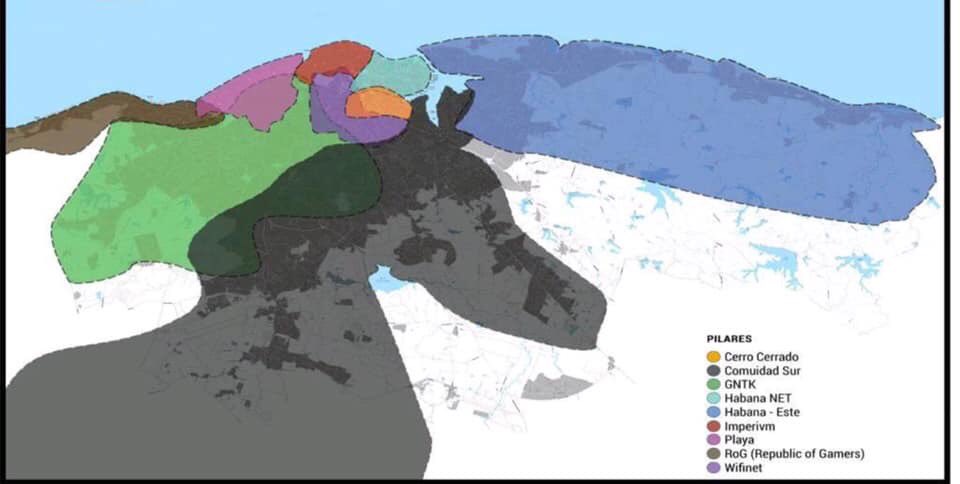The controversy over a possible dismantling of SNET arises after last week the Cuban government announced new resolutions authorizing the import of equipment to establish wireless connections, as well as regulations that recognize and regularize local private networks, as in the case of the abovementioned SNET.
SNET defined itself in 2016 as “an independent non-profit project, which uses the latest technologies available to create wireless and land-line networks that interconnect people, families and communities throughout Havana and nearby areas,” according to a statement released by its administrators.
In the document, which circulated on the social networks and other digital channels, SNET explains the reasons why its users do not agree with the new regulations, which, after years of waiting, finally give a legal framework to individuals’ operations of data networks.
The creators of the document, available on a public Dropbox public link, explained anonymously that they value “positively the intention, within the process of computerization of Cuban society, to optimize the use of the radio spectrum and generate a legal framework so that people, individually, or associated under certain limits, can connect from their homes in an orderly manner to the infrastructure of ETECSA, and import equipment accordingly.”
Following this, they offer a detailed explanation of the nonconformities with respect to the regulations and how they may attack the spontaneous structure that makes up the SNET.
“There are issues in the new regulations that threaten the possible legalization of a metropolitan network like SNET and its similar ones in other provinces in the country, or that under those arguments are impossible to adapt to what is defined in the regulation,” they affirm.
What are these aspects?
-The limits established for the power of the equipment used to provide Wi-Fi.
Although the explanation is quite technical and specific, the administrators of SNET argue that by limiting the maximum power of emission of individuals’ equipment, the managers of the connection nodes could not adjust the profit of the equipment and the output of the antenna without “disproportionately radiating power,” something the legislation forbids.
This means that wireless networks can only have a range of 400 meters (according to the regulation), when currently some of the SNET equipment covers kilometers. The power of the allowed equipment would be enough to connect just three or four blocks, in case there is no interference obstacle that decreases that range.
-The prohibition of (transversal) direct links between two networks without ETECSA’s mediation.
According to the regulation, point-to-point links would only be contemplated for legal entities (companies, institutions, etc.) and not individuals (private networks).
-The non-possibility of Mesh networks.
The proposed regulations do not contemplate this possibility of connections between private networks, whose infrastructure is dynamic and non-hierarchical, which allows several nodes to connect between each other at the same time, without the need for a centralized structure.
“Although this is detrimental to SNET and similar networks (more latency, less stability), it would be a way to reduce costs in an attempt to comply to some extent with the regulation,” the SNET administrators argued.
–The difficulties of connecting properly to ETECSA.
If people can’t connect to ETECSA’s network, they would have virtually no access to SNET, according to the new regulations, but the remoteness of most homes from public connection points is not considered. To maintain the current connection structure, SNET users would require an expensive deployment of equipment that guarantees a device every 3-4 blocks.
Otherwise, there should be multiple points with powerful equipment (only provided by ETECSA in specific points of the city) that provide Wi-Fi and guarantee the connection, they explained.
-Connections without quality for videogames.
“Highly consumed services that require low latency (one of the fundamental principles of SNET) such as videogames, streaming, which are now a means of recreation, would be significantly affected, increasing the latency to more than 80ms,” they argued.
-Expensive equipment.
“The regulation forces the community of SNET and similar ones to incur in additional costs for acquisition and maintenance of a greater quantity of equipment, with the aim of being able to join some blocks in a locality,” said the administrators.
A (giant) street network
Although for the first time in 2016 SNET is openly spoken about in the official press, the network emerged several years before, close to 2000, and currently covers almost all the municipalities of Havana and surrounding areas, although there are also similar networks in other provinces in the country.

SNET user Yoel Estévez shared a video taken four years ago that illustrates in some way how the “street network” works from inside and the different forms of interaction.
https://www.facebook.com/yoel.estevez.3/videos/2034551420007620/?t=0
Fidel Alejandro Rodríguez, a professor of the University of Havana, explains that “the main use of these networks is playing videogames.”
“It is also one of the main dynamics that drive and condition its development and transformation. For this, they are articulated in multiple pillar and neighborhood nodes depending on the most popular videogames such as Dota, Warcraft or Call of Duty, through a complex distributed network of medium and low range antennas, as well as LAN cables that cross buildings and rooftops,” Fidel Alejandro wrote in a research on the subject shared with OnCuba.
Although the world of gamers predominates, the network allows sharing information and databases of movies, books, etc., as well as several social networks similar to Facebook. The closest thing to the Internet outside the Internet.
No suelo comentar mucho tus tweets, pero este si me voy a tomar el trabajo de comentarlo. Pioneros en el proceso de informatización de #Cuba son #Snet #WifiHLG y todas las redes callejeras (censuradas por años) que hace más de 10 años están informatizando el país a cambio de nada
— Raul Alderete (@XC0D3) June 2, 2019
Neither is much known about the actual scope of this network and its users. While in 2016 some 20,000 people were counted, according to Cubadebate, today the very members calculate in their discussion forums that they could reach 40,000 nodes, which would mean that many more people would have access to the network (if we count that there can be several users and computers in the same house).
The way in which networks are economically supported (whether physical equipment for Wi-Fi, and other management elements) is based on an idea of non-profit collaboration. Some of the sources explain that you pay between 1 CUC and 3 CUC per month, which goes to the administrators of the networks.
Rodríguez explains that “their support is based on the collaborative work of users through collections, where sometimes the private contribution is higher and decisive.”
Although the network doesn’t have a centralized structure, most users must accept rules for its collective use. Included among those rules shared by all is the prohibition of political and religious debate, not sharing the Internet in these ways and not divulging internal information about SNET (although several of the members have offered interviews to the media).
Paradoxically, in addition, this last requirement would be violated by hundreds of members who started the campaign to collect the signatures, because they would be divulging “what they do and who they are” in order to look for supporters for their cause.
Rodríguez also points out in his research that “the public agenda of subversion in these areas organized by the U.S. government and the consequent defensive attitude of the Cuban State, place these initiatives in an area of constant observation and suspicion on the part of society as a whole, which implies a deforming determinant factor in its evolution.”
SNET, does it stay or does it go?
In its official Facebook group, SNET describes itself as “the largest independent wireless community in the world.” And they add that they are “enterprising, talented and ingenious. We are the street, the neighborhood, the municipality, the province and the country. We are a great family inside and outside Cuba … we #SOMOSSNET.”
Eliecer Camejo Pérez, one of the members of this urban network and user of the group on Facebook, commented that “SNET was simply born because there was a social need that neither ETECSA nor the Ministry of Communications were interested in.”
“Now they can’t pretend to be the heroes of the story, to disappear us or to erase our history !!!!!!” he said while sharing a photo of a closed fist with the phrase #fuerzaSnet.
Other users regret the damage that closing a project that was already part of their daily lives could cause them and that with the new requirements would be impossible to sustain.
https://www.facebook.com/photo.php?fbid=1436256383183075&set=a.484324995042890&type=3&theater
Loyett Sigarroa said on Facebook that he has been managing a page on this network for two years, for which he doesn’t earn “a cent” but he does invest money and time, “working until the early morning hours without sleep.”
“I am demanding my rights as a citizen and nobody can prevent that,” he said in response to the people who ask him to be “silent” and “calm” in the face of the new regulations of the Ministry of Communications.
“The dream of thousands of young people is being destroyed and the tranquility of thousands of parents who have their children sitting in front of their computers chatting, making friends, playing…. It hurts me to say goodbye to my dreams, to my website, the one that has given me and many others so many good times for 5 years,” Yoel Estévez said in his personal Facebook account.
https://www.facebook.com/photo.php?fbid=2033981236731305&set=a.836845979778176&type=3&theater
The proposal of a group of administrators (still seeking unity among their fellow users) was to collect signatures from users and supporters to show disagreement with the new regulations.
Esto es #SNET en la habana pic.twitter.com/8cz72KGUb7
— Adalberto Orta Pozo .•. (@anubis_linux) June 3, 2019
To reach 10,000 signatures, users must comply with all the requirements demanded by law for these cases, such as being of legal age, not serving criminal sentences, as well as creating a well-thought-out proposal for legislation.
According to outstanding academic Julio César Guanche, “if it is a proposal of 10,000 citizens, in addition to the arguments described above, they must provide a sworn statement before a notary, where the personal identity is certified by means of the identity card data, as well as the capacity to vote.”
The proposal made by the SNET administrators to government officials was to “assess a special tailor-made license for SNET, which allows it to connect to the national network, access the services offered by ETECSA, and allow this network to continue operating for the benefit of its members and contributing to the process of computerization of society as it has been doing all this time,” they published in their communiqué of June 1st.
However, Yudivián Almeida, professor of the Faculty of Mathematics and Computing, does not agree that there is an exception only for SNET, but that in general “the creation of community networks and their interconnection between them should be allowed without the need of going through the public network, and point-to-point connections between them should be allowed,” he told OnCuba.
“Of course, now we only have some ministerial resolutions. It would be necessary to design a legislation that makes these measures invalid and develops another point of view,” he concluded.
The controversy over the future of the street network in Cuba is inserted in a context where Cubans are beginning to raise their voices on social networks to demand what they believe is fair: from an independent march in favor of the LGBTIQ community, another march convened on the social networks in favor of an animal protection law, spontaneous and organized help on the Internet for victims of a tornado or a campaign on Twitter to demand price reduction for access to the Internet.
The new cause of SNET users does not show a solution in plane view and next July it could face a radical change in the way it has been conceived as an independent network for more than a decade.









